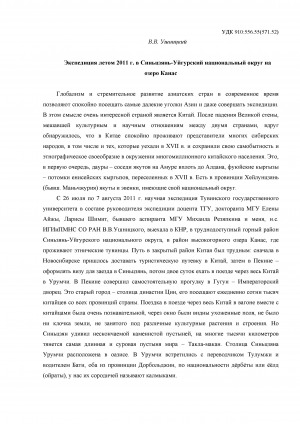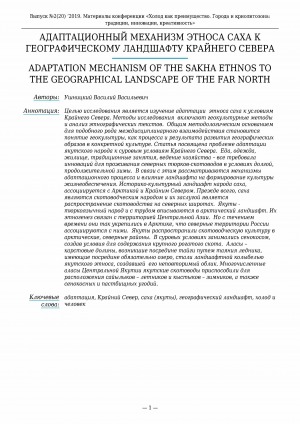Количество страниц: 6 с.
The problem article discusses the stages of ethnogenesis of the Evenki people in the territory of modern Yakutia. First, a substrate of Paleo-Asian origin is studied, dating back to the population of the Neolithic period. Then came the Turkic-Mongolian stage, associated with the ethnonyms Tungus, Evenk (Uvan). The complexity of the ethnogenesis of the Altai peoples is shown by the fact that the self-names of the Mongols and Sakha possibly go back to the ancient ethnonyms ofthe Tungus-Manchu peoples of the Sakhalin Mohe. It is believed that the ethnonym Even was first recorded in the form of the "deer” people of Uvan in the southern Transbaikalia of the 7th century. Wuhan in Chinese and Russian historiography are considered the descendants of ancient Wuhan. In the ethnogenesis of the Evenks, one can see the participation of the Mongolian component associated with stray tribes of the Da Shivei tribe. They can be called the descendants of the Mongol-speaking people of the Syanbi, who in the Mongol tradition were designated the ethnonym Chorus, Hori. Evenki ethnonyms similar to Mongolian ones should be attributed to the Mongolian substrate in the ethnogenesis of Evenki.
Ушницкий, В. В.
Этапы заселения предками эвенков территории Якутии / Ушницкий В. В. ; Институт гуманитарных исследований и проблем малочисленных народов Севера СО РАН // Народы и культуры Северной Азии в контексте научного наследия Г. М. Василевич : сборник научных статей /ответственный редактор Л. И. Миссонова ; редакционная коллегия: А. Н. Варламов, Н. И. Данилова, Е. Г. Маклашова [и др.] ; рецензенты: Т. В. Аргунова, Т. Г. Басангова, В. Н. Давыдов ; ответственный за выпуск М. П. Дьяконова. - Якутск : ИГИиПМНС СО РАН, 2020. - С. 106-111. - DOI: 10.25693/VasiIevich.2020.017
DOI: 10.25693/VasiIevich.2020.017
Количество страниц: 10 с.
The article is devoted to the impressions from trips to conferences in the republics of the South Siberia to Tuva, Khakassia and Altai Mountains. Such trips complement the portfolio of researchers with new materials, enabling you to see the object of study for yourself, freely navigate the geography of the area and meet with local scientists. Visits to local museums, rich in archaeological artifacts and monuments of runic writing, as well as the chance to see archaeological sites directly in the field allow to plunge into the past and experience the continuous connection time.
Ушницкий, В. В. Поездки в тюркские республики Южной Сибири: впечатления этнографа = Trips to the South Siberia: the experience of the ethnographer / В. В. Ушницкий ; Институт гуманитарных исследований и проблем малочисленных народов Севера // Северо-Восточный гуманитарный вестник. - 2014, N 1 (8). - С. 111-116.
Количество страниц: 8 с.
This article deals with the problem of the horolors in the ethnogenesis of Sakha, who were considered the sons of the Sun, and who revered the Eagle and the Crow. The Yakut people were well associated with the Trans-Baikal Chorintsy, and this was so strengthened in the scientific literature that they are also considered the Chorinians. Horintsev, in turn, is associated with the Kurykans, Chorus shivei, with Mongolian tribes, the Horlases and Horchins. A separate phratry of the Chorintsy is considered to be the Tumat and Batulintsy, also found in the generic Sakha. The possibility of ethnic connection of the chorolors with bargots and dauri-Mongolian-speaking peoples living in Inner Mongolia, as well as with the Hoorai (the self-name of the Khakas) is being explored. In folklore texts are emphasized that they had their own language, their language was used by shamans in their rituals. The etymological relationship of the Yakut word Horo with ethnonyms Croats, Hurrit-choir (worshipers of the cult of the Sun-Horse), with the Yuezhi-Choir and Tokhars, the Paleo-Asiatics of Kore-Korea, and the Tungus word k'or are derived from the Koryak derivative. Thus, the term horo has both northern parallels and Central Asian, linking the ancestors of Sakha with the ancestors of Mongolian-speaking peoples.
Ушницкий, В. В. Хоролоры Якутии: история вопроса (анализ и новейшие интерпретации) / В. В. Ушницкий ; Институт гуманитарных исследований и проблем малочисленных народов Севера // Северо-Восточный гуманитарный вестник. - 2017, N 2 (19). - С. 21-28.
Количество страниц: 8 с.
The paper analyzes the generic composition Boturusskogo ulus. Subsequently, this formed ulus Churapchinsky, Tattinsky and Amginsky region. We examine the etymological connection generic name Baturusskogo ulus with the Turko-Mongolian ethnonyms. Analysis of the generic names ulus indicates proximity to the ancestors of the ulus Turko- Mongol tribes Transbaikalia, ulus population is made up of a number of major birth Hatyly, Bөtүҥ, Bologur, Sylaҥ.
Ушницкий, В. В.
Этногония Батурусского улуса: родовые названия и якутские волости XVII века / В. В. Ушницкий ; Институт гуманитарных исследований и проблем малочисленных народов Севера // Северо-Восточный гуманитарный вестник. - 2016, N 2 (15). - С. 10-17.
Количество страниц: 6 с.
This article is described the field experiment of the author as a part of an ethnographic expedition of the Tuva State University in the Xinjiang Uyghur Autonomous Region, national region of the People's Republic of China in 2011. Within the narration "the culture model" of the Tuva people is in detail told about living conditions of a field expedition. The amazing hospitality of Tuvan villages Horn and Kanas, acquaintance with national cuisine let you plunge into the local atmosphere, imbued with their way of life. Tuvinians living in Chinese Altai, around the Lake Kanas, preserved their ancient culture. There the influence of Russian culture on Chinese Tuvan, is noted as a result of living together in the valley with the Russian Old Believers in the first half of XX century. The main occupation of the Tuvan population in the area of the Lake Kanas is ethnic tourism. Ihe Chinese government strongly supports and subsidizes this direction, at the same time prohibits a traditional activity: hunting and animal husbandry. In the Tuvan villages together inhabited by indigenous nationalities of Xinjiang Kazakhs. Kyrgyz, Uighurs. Dungans and the Mongols (Oirats). Tuvans of China known as Kok-Monchaki and Uriyangkhai. Tuva retained many of the traditional customs of the Turkic peoples of Central Asia, which was lost by the peoples of South and Hast Siberia in the first decades of the Soviet authorities during collectivization.
Ушницкий, В. В.
Этнографические этюды (один день из полевой экспедиции в Синьцзян) / В. В. Ушницкий ; Институт гуманитарных исследований и проблем малочисленных народов Севера СО РАН // Северо-Восточный гуманитарный вестник. - 2016, N 4 (17). - С. 122-127.
Количество страниц: 10 с.
Historiography of the ethnogenesis of the Sakha has more than 300 years. Foreign and domestic travelers have always been interested in the question of the origin of Turkic cattle-breeders in the Far North. The historiography of the topic in the period of Imperial Russia and folklore along with information of Oriental research, received a popular exposition in the famous work of G. V. Ksenofontov "Uraankhay-sahalar". The questions of ethnogenesis of the Sakha were engaged leading scientists, eminent scholars V. V. Radlov and O. N. Betlingk, archaeologist A. P. Okladnikov and ethnographer B. O. Dolgikh and S. A. Tokarev. A comprehensive study of the subject was reflected in the works of I. V. Konstantinov and A. I. Gogolev with a wide coverage of the range of archaeological and ethnographic data on the people of Sakha. Researchers point to the presence of Sakha ethnogenesis of Indo-Iranian, Kimako-Kipchak, Tele-Oghuz and Mongolian components. In the Soviet period the linkage of the Yakut culture with Kurykanskaya in archaeological terms – Kulun-Atakhskaya culture of the Middle Lena with Kurumchinskaya in the Baikal region. Detection of Ust-Tallinskoy archaeological culture in the Southern Angara region has allowed more details to associate their carriers with the population, who brought in the XVI century burial with a horse on the territory of Yakutia. Extensive historiography of the problem is allowed to operate with different information from written sources. These data suggest migration from the territory of Baikal and Southern Siberia of various ethnic groups of native ethnonyms of Sakha, Uraankhay, Tumat, Bootulu, Baiagantay, Horo and their participation in the ethnogenesis of the Sakha people of the Middle Lena.
Ушницкий, В. В. Историография этногенеза саха: обзор научных гипотез и популярных версий (XVII-XXI вв.) / В. В. Ушницкий ; Институт гуманитарных исследований и проблем малочисленных народов Севера // Северо-Восточный гуманитарный вестник. - 2017, N 1 (18). - C. 10-19.
Количество страниц: 4 с.
This article discusses the origin of the batulinsky genus, played a major role in the ethnogenesis of the Sakha andBuryats. This is evidenced by the historiographical materials saved up from the XVIII century after work of the Kamchatka expeditions. Toponymic and folklore sources say of the importance role of batulin’s people in the ethnogenesis of the Yakut uluses: Namsky, Baturussky and Viliuy and Verkhoyansk groups Yakuts.
Ушницкий, В. В. Батулинская проблема в этногенезе саха и бурятов / В. В. Ушницкий ; Институт гуманитарных исследований и проблем малочисленных народов Севера // Северо-Восточный гуманитарный вестник. - 2015, N 2 (11).
Количество страниц: 6 с.
The author, the participant of expedition of the Tuva state university, tells about visiting there mote mountainous area of the Sintszyan-Uygursky national district. Expedition got acquainted with life of the Tuvinians living in an environment of the multimillion Chinese population and managed to keep language and customs.
Ушницкий, В. В. Экспедиция летом 2011 г. в Синьцзянь-Уйгурский национальный округ на озеро Канас / В. В. Ушницкий ; Институт гуманитарных исследований и проблем малочисленных народов Севера // Северо-Восточный гуманитарный вестник. - 2013, N 1 (6). - С. 103-106.
Количество страниц: 7 с.
The article is devoted Daur - Amur people are living in China now. During the expedition to Inner Mongolia in the summer of 2013, it was possible to get acquainted with the culture of the people. Daur considered descendants of the Khitans were engaged in farming and horticulture. Daur penetrated into the territory of Yakutia was entered in the ethnocultural contacts with representatives of the Sakha people. Sakha alleged links with Daur, reflected in similar ethnonyms, national games.
Ушницкий, В. В. Дауры: новые этнографические материалы / В. В. Ушницкий ; Институт гуманитарных исследований и проблем малочисленных народов Севера // Северо-Восточный гуманитарный вестник. - 2014, N 1 (8). - С. 30-33.
Количество страниц: 3 с.
Ушницкий, В. В. Адаптационный механизм этноса саха к географическому ландшафту Крайнего Севера / В. В. Ушницкий ; Институт гуманитарных исследований и проблем малочисленных народов Севера // Научный электронный журнал Меридиан. - 2019. - N 2 (20). - C. 156-158.









